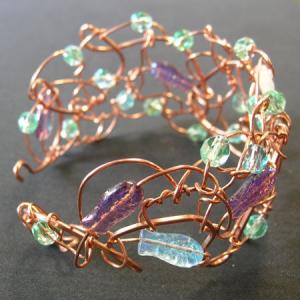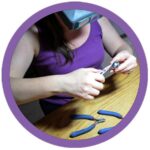As a follow-up to my rant, I thought I should post a photo of some of my earliest work. When I’m teaching raw beginners, I always suggest that they should keep their first pieces, so that years from now they’ll be able to see how far they’ve come. I have a box full of my early pieces. Most are completely unsellable, and some are butt ugly, but I remember being so proud of them when they were first made.

Some years later, I was dating a accountant who collected Inuit and Native art, and had a taste for the finer things in life: Cuban cigars, $50/shot whiskey and Angus beef. He had a very discerning eye, and was very willing to tell me when the work I produced did not show “The Spark of Divine Madness”, as he called it. His criticisms, though sometimes really hard to hear, helped me to gain an understanding of where I needed to improve.
Outside of a formalized education environment, there are very few opportunites to get truly constructive feedback. It’s frustrating to submit your work to a show or a publication and have it rejected without any explanation. It shakes the ego, and it’s hard not to question every aspect of what you do as a result. Is my work no good, did I not take good photos, was my artist statement crap? What??
The International Guild of Wire Jewelry Artists recognized the need for this type of mentoring, and set up a special section on their message board specifically for honest critique. It’s sometimes a challenge to suspend attachment to the piece being critiqued; it helps to know that the observations are made with open hearts in the true spirit of helping each other improve. I’ve used it myself and gotten immensely valuable commentary.
Alot of the energy behind my rant stemmed from knowing the impact on newbies when they learn the proper foundation skills. The ability to create quality workmanship results in a corresponding increase in confidence and self-esteem.
Because wirework is perceived as being easy to do, special attention needs to be given to helping the public and the makers understand the importance of learning the right skills the right way. As the full-time students who took my class found out, working with wire can require a high degree of dexterity, even for “simple” projects. Many of them found it much more challenging than they expected.
Several people who responded to the discussion on one of the forums asked for further information about wire control. I’m in the process of working something up and will publish it when it’s ready.
Almost 15 years ago, I started with these bits. They are my reminder that we all start somewhere. Where we end up depends on a combination of our own drive and the support of those around us.
(Thanks to George, wherever he is, and to Karen and Jennifer. And special thanks to Jacqueline, who at age 5, crawled up on my lap, and while fiddling with the pendant on the leather cord above, said “Y’know, I knew I was going to like you the moment I met you.” When asked why, she said quietly: “Because you make great jewellery!”)

 Undercurrents Earrings
Undercurrents Earrings

